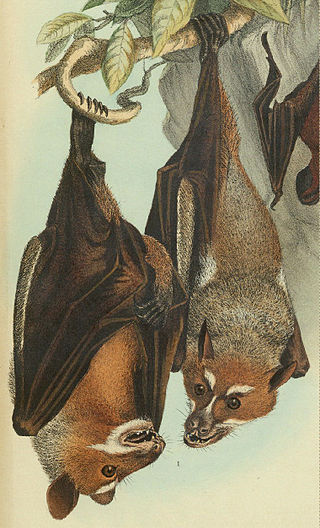
Bubalus is a genus of Asiatic bovines that was proposed by Charles Hamilton Smith in 1827. Bubalus and Syncerus form the subtribe Bubalina, the true buffaloes.

The tamaraw or Mindoro dwarf buffalo is a small buffalo belonging to the family Bovidae. It is endemic to the island of Mindoro in the Philippines, and is the only endemic Philippine bovine. It is believed, however, to have once also thrived on the larger island of Luzon. The tamaraw was originally found all over Mindoro, from sea level up to the mountains, but because of human habitation, hunting, and logging, it is now restricted to only a few remote grassy plains and is now a critically endangered species.

The genus Chrotomys contain a unique group of rodents found only in the Philippines, specifically the islands of Luzon, Mindoro, and Sibuyan. Instead of being predominantly herbivorous or omnivorous like other murines, these rats feed predominantly on invertebrates although they do eat some vegetable matter. This vermivory is probably the result of a rat-like animal moving into an ecological niche usually filled by shrews. Shrews and other insectivores are absent on these Philippine islands.

The Philippine crocodile, also known as the Mindoro crocodile, the Philippine freshwater crocodile, the bukarot in Ilocano, and more generally as a buwaya in most Filipino lowland cultures, is one of two species of crocodiles found in the Philippines; the other is the larger saltwater crocodile (Crocodylus porosus). The Philippine crocodile, the species endemic only to the country, went from data deficient to critically endangered in 2008 from exploitation and unsustainable fishing methods, such as dynamite fishing. Conservation methods are being taken by the Dutch/Filipino Mabuwaya foundation, the Crocodile Conservation Society and the Zoological Institute of HerpaWorld in Mindoro island. It is strictly prohibited to kill a crocodile in the country, and it is punishable by law.
The Mindoro scops owl is an owl that is native to the Mindoro island in the Philippines. It is found in tropical moist montane forests above 870 masl. It is threatened by habitat loss. It is one of the three highland specialist scops owls which includes the Luzon scops owl and the Mindanao scops owl.

The Mindoro climbing rat or Mindoro rat is a species of rodent in the family Muridae. It is found only in the Philippines, and is known only from Ilong Peak in the Halcon Mountains. It is the only species in the genus Anonymomys. Its natural habitat is subtropical or tropical dry forest. It is threatened by habitat loss.

The Mindoro striped rat is a species of rodent in the family Muridae. It is found only in the Philippines.

The Mindoro black rat is a species of rodent in the family Muridae. It is found only in hilly and forested areas of Mindoro island, the Philippines.

The Philippine coucal is a species of cuckoo in the family Cuculidae. It is endemic to the Philippines. It is an insectivore.

The Mindoro imperial pigeon, also known as Mindoro zone-tailed pigeon, Great Mindoro pigeon or Pink-throated Imperial pigeon, is a bird species in the family Columbidae. It is endemic to the mountains of Mindoro in central Philippines and is the largest pigeon in the country reaching 50cm in length.

The Wallace's or Sulawesi stripe-faced fruit bat is a species of megabat in the family Pteropodidae. It is endemic to Sulawesi and the nearby Togian Islands of Indonesia. Cave paintings resembling these bats have been found in Australia, where bats of this kind are not otherwise known.

Styloctenium is a genus of stripe-faced fruit bat in the Pteropodidae (megabat) family. It comprises the following species:
The Mindoro stripe-faced fruit bat, nicknamed the "flying fox" for its foxlike face, is a species of large megabat that is endemic to the island of Mindoro. The Mindoro stripe-faced fruit bat ranked sixth in the top ten species of 2008, selected by the International Institute for Species Exploration.

The Mindoro boobook or Mindoro hawk-owl is a species of owl in the family Strigidae that is endemic to the Philippines.

Sybra is a genus of beetles in the family Cerambycidae, containing the following species:

The Mindoro racket-tail is a species of parrot in the Psittaculinae family. It was formerly considered conspecific with the blue-crowned racket-tail. It is endemic to the island of Mindoro in the Philippines and it occurs in tropical moist lowland forest. It is threatened by habitat loss and trapping for the cage-bird trade.

Sybra umbratica is a species of beetle in the family Cerambycidae. It was described by Francis Polkinghorne Pascoe in 1865.
Sybra uenoi is a species of beetle in the family Cerambycidae. It was described by Hayashi in 1956. It is known from Japan.

Sybra ordinata is a species of beetle in the family Cerambycidae. It was described by Henry Walter Bates in 1873.
The Mindoro narrow-disked gecko is a species of gecko. It is endemic to the Philippines.
- Lifespan: These geckos typically live for 5 to 10 years.
- Diet: As insectivorous reptiles, they feed on a diverse range of invertebrates. Their menu includes various species of beetles, worms, spiders, and orthopterans. Their voracious and opportunistic feeding habits help them thrive in their natural habitat.
- Appearance: The Mindoro narrow-disked gecko is medium-sized, covered in smooth, rough-textured skin. Its body displays a distinct cream to light yellow coloration with dark brown banding. Interestingly, males have relatively larger heads and tails compared to females—a unique feature within this species. However, there are no prominent markings or other notably unique physical traits observed in this gecko.
- Behavior: These geckos are nocturnal and solitary. They excel at vertical climbing in their tropical habitats. Their camouflaged skin allows them to stealthily hunt insects at night. Additionally, males exhibit territorial behavior,















